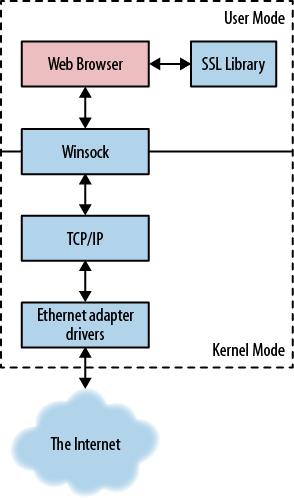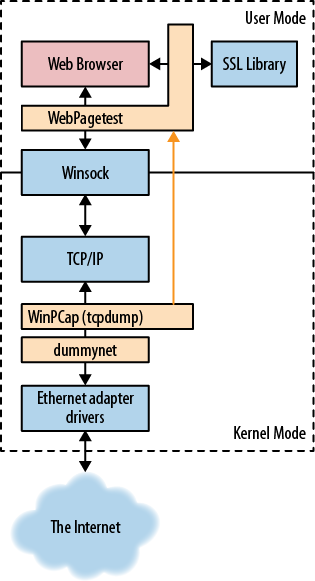I thought Iâd take the opportunity this year to give a little bit of visibility into how WebPagetest gathers the performance data from browsers. Other tools on windows use similar techniques but the information here may not be representative of how other tools work.
First off, it helps to understand the networking stack on Windows from a browserâs perspective (Figure 1-1).
It doesnât matter what the browser is, if it runs on Windows, the architecture pretty much has to look like the diagram above where all of the communications go through the Windows socket APIs (for that matter, just about any application that talks TCP/IP on Windows looks like the picture above).
The key to how WebPagetest works is its ability to intercept arbitrary function calls and inspect or alter the request or response before passing it on to the original implementation (or choosing not to pass it on at all). Luckily someone else did most of the heavy lifting and provided a nice open source library (http://newgre.net/ncodehook) that can take care of the details for you but it basically works like this:
Find the target function in memory (trivial if it is exported from a dll).
Copy the first several bytes from the function (making sure to keep x86 instructions intact).
Overwrite the function entry with a jmp to the new function.
Provide a replacement function that includes the bytes copied from the original function along with a jmp to the remaining code.
Itâs pretty hairy stuff and things tend to go very wrong if you arenât extremely careful, but with well-defined functions (like all of the Windows APIs), you can pretty much intercept anything youâd like.
One catch is that you can only redirect calls to code running in the same process as the original function, which is fine if you wrote the code but doesnât help a lot if you are trying to spy on software that you donât control which leads us toâ¦
Lucky for me, Windows provides several ways to inject arbitrary code into processes. There is a good overview of several different techniques here: http://www.codeproject.com/KB/threads/winspy.aspx, and there are actually more ways to do it than that but it covers the basics. Some of the techniques insert your code into every process but I wanted to be a lot more targeted and just instrument the specific browser instances that we are interested in, so after a bunch of experimentation (and horrible failures), I ended up using the CreateRemoteThread/LoadLibrary technique which essentially lets you force any process to load an arbitrary dll and execute code in it (assuming you have the necessary rights).
Now that we can intercept arbitrary function calls, it just becomes a matter of identifying the âinterestingâ functions, preferably ones that are used by all the browsers so you can reuse as much code as possible. In WebPagetest, we intercept all the Winsock calls that have to do with resolving host names, connecting sockets, and reading or writing data (Figure 1-2).
This gives us access to all the network access from the browser and we essentially just keep track of what the browsers are doing. Other than having to decode the raw byte streams, it is pretty straightforward and gives us a consistent way to do the measurements across all browsers. SSL does add a bit of a wrinkle so we also intercept calls to the various SSL libraries that the browsers use in order that we can see the unencrypted version of the data. This is a little more difficult for Chrome since the library is compiled into the Chrome code itself, but luckily they make debug symbols available for every build so we can still find the code in memory.
The same technique is used to intercept drawing calls from the browser so we can tell when it paints to the screen (for the start render measurement).
Since WebPagetest is under a BSD license you are welcome to reuse any of the code for whatever purposes youâd like. The project lives on Google Code here: (http://code.google.com/p/webpagetest/) and some of the more interesting files are:
Winsock API interception code (http://webpagetest.googlecode.com/svn/trunk/agent/wpthook/hook_winsock.cc)
Code injection (http://webpagetest.googlecode.com/svn/trunk/agent/wpthook/inject.cc)
Luckily, browsers are starting to expose more interesting information in standard ways and as the W3C Resource Timing spec (http://w3c-test.org/webperf/specs/ResourceTiming/) advances, you will be able to access a lot of this information directly from the browser through JavaScript (even from your end users!).
Note
To comment on this chapter, please visit http://calendar.perfplanet.com/2011/webpagetest-internals/. Originally published on Dec 01, 2011.
Get Web Performance Daybook Volume 2 now with the O’Reilly learning platform.
O’Reilly members experience books, live events, courses curated by job role, and more from O’Reilly and nearly 200 top publishers.



